A Time-Interleave-Based Power Management System with Maximum Power Extraction and Health Protection Algorithm for Multiple Microbial Fuel Cells for Internet of Things Smart Nodes
Abstract
1. Introduction
2. MFC and Power Management System Specification
2.1. MFC Construction and Characterization
2.2. MFC Electrical Equivalent Modeling
2.3. System Specifications
3. Circuit Architecture for Multi-MFC PMS
3.1. Overview of Energy Harvesting for MFC
3.2. Overview of the Proposed PMS Circuit for Multi-MFC
3.3. Maximum Power Point DC-DC Converter
3.4. Multi-MFC PMS Algorithm
- The Power Ranking Algorithm subroutine (described in Section 3.5) is executed. As a return variable, a look-up table is filled out with the individual MFCs’ power rankings
- The look-up table is accessed to interleave the MFC power extraction process
- The DC-DC boost converter is enabled to start EH
- VMFC is compared to the low threshold voltage
- When voltage is reached the DC-DC converter is disabled
- If more MFCs in the array are waiting to be harvested, then the program jumps to instruction #2. Otherwise, the system stops its EH mode and waits until the recovery time of the highest ranked MFC is reached
- After the recovery time is completed, the algorithm restarts.
3.5. Power Ranking from Multiple MFCs
- The power ranking measurement capacitor is initialized to 0 V by Cap Discharge switch
- The MFC under testing is connected to the ranking circuit using Cap Charge switch
- ADC values of MFC measured power are stored in the look-up table
- The ADC values are sorted, assigning the highest rank to the MFC with maximum voltage, and lowest rank to the MFC with minimum voltage. MFCs that cannot provide significant power are ranked zero and neglected in the subsequent EH process.
3.6. Implementation
4. Experimental Results and Discussion
4.1. PMS for Multiple MFCs
4.2. IoT Sensor Node Application
4.3. Total Power Consumption and Efficiency
5. Conclusions
Supplementary Materials
Author Contributions
Funding
Acknowledgments
Conflicts of Interest
References
- Chong, C.Y.; Kumar, S.P. Sensor networks: Evolution, opportunities, and challenges. Proc. IEEE 2003, 91, 1247–1256. (In English) [Google Scholar] [CrossRef]
- Gèungèor, V.ð.; Hancke, G.P. Industrial wireless Sensor Networks: Applications, Protocols, And Standards; (Industrial Electronics Series), PP. 1 Online Resource (xxxii, 374 Pages); CRC Press: Boca Raton, FL, USA, 2017. [Google Scholar]
- Tiwari, A.; Lewis, F.L.; Ge, S.S. Wireless sensor network for machine condition based maintenance. In Proceedings of the 2004 8th Control, Automation, Robotics and Vision Conference, Kunming, China, 6–9 December 2004; pp. 461–467. (In English). [Google Scholar]
- Swartz, R.A.; Lynch, J.P.; Zerbst, S.; Sweetman, B.; Rolfes, R. Structural monitoring of wind turbines using wireless sensor networks. Smart Struct Syst. 2010, 6, 183–196. (In English) [Google Scholar] [CrossRef]
- Konstantopoulos, C.; Koutroulis, E.; Mitianoudis, N.; Bletsas, A. Converting a Plant to a Battery and Wireless Sensor with Scatter Radio and Ultra-Low Cost. IEEE Trans. Instrum. Meas. 2016, 65, 388–398. (In English) [Google Scholar] [CrossRef]
- Toh, W.Y.; Tan, Y.K.; Koh, W.S.; Siek, L. Autonomous Wearable Sensor Nodes with Flexible Energy Harvesting. IEEE Sens. J. 2014, 14, 2299–2306. (In English) [Google Scholar] [CrossRef]
- Wang, Y.; Lynch, J.P.; Law, K.H. Design of a low-power wireless structural monitoring system for collaborative computational algorithms. Proc. Soc. Photo-Opt. Instrum. 2005, 5768, 106–117. (In English) [Google Scholar]
- Atzori, L.; Iera, A.; Morabito, G. The Internet of Things: A survey. Comput. Netw. 2018, 54, 2787–2805. (In English) [Google Scholar] [CrossRef]
- Seah, W.K.; Tan, Y.; Chan, A.T. Research in energy harvesting wireless sensor networks and the challenges ahead. In Autonomous Sensor Networks; Springer: Berlin, Germany, 2012; pp. 73–93. [Google Scholar]
- Wan, Z.G.; Tan, Y.K.; Yuen, C. Review on energy harvesting and energy management for sustainable wireless sensor networks. In Proceedings of the 2011 IEEE 13th International Conference on Communication Technology, Jinan, China, 25–28 September 2011; pp. 362–367. [Google Scholar]
- Raghunathan, V.; Kansal, A.; Hsu, J.; Friedman, J.; Srivastava, M. Design considerations for solar energy harvesting wireless embedded systems. In Proceedings of the Fourth International Symposium on Information Processing in Sensor Networks, Boise, ID, USA, 15 April 2005; pp. 457–462. (In English). [Google Scholar]
- Zarate-Roldan, J.; Carreon-Bautista, S.; Costilla-Reyes, A.; Sanchez-Sinencio, E. A Power Management Unit With 40 dB Switching-Noise-Suppression for a Thermal Harvesting Array. IEEE Trans. Circuits Syst. I Reg. Pap. 2015, 62, 1918–1928. (In English) [Google Scholar] [CrossRef]
- Calhoun, B.H.; Daly, D.C.; Verma, N.; Finchelstein, D.F.; Wentzloff, D.D.; Wang, A.; Cho, S.-H.; Chandrakasan, A.P. Design considerations for ultra-low energy wireless microsensor nodes. IEEE Trans Comput. 2005, 54, 727–740. (In English) [Google Scholar] [CrossRef]
- Vullers, R.J.M.; Schaijk, R.v.; Visser, H.J.; Penders, J.; Hoof, C.V. Energy Harvesting for Autonomous Wireless Sensor Networks. IEEE Solid-State Circuits Mag. 2010, 2, 29–38. [Google Scholar] [CrossRef]
- Moghe, R.; Yang, Y.; Lambert, F.; Divan, D. A Scoping Study of Electric and Magnetic Field Energy Harvesting for Wireless Sensor Networks in Power System Applications. In Proceedings of the 2009 IEEE Energy Conversion Congress and Exposition, San Jose, CA, USA, 20–24 September 2009; Volumes 1–6, pp. 3423–3430. (In English). [Google Scholar]
- Wang, H.M.; Park, J.D.; Ren, Z.Y. Active Energy Harvesting from Microbial Fuel Cells at the Maximum Power Point without Using Resistors. Environ. Sci. Technol. 2012, 46, 5247–5252. (In English) [Google Scholar] [CrossRef] [PubMed]
- Logan, B.E.; Hamelers, B.; Rozendal, R.; Schröder, U.; Keller, J.; Freguia, S.; Aelterman, P.; Verstraete, W.; Rabaey, K. Microbial fuel cells: Methodology and technology. Environ. Sci. Technol. 2006, 40, 5181–5192. (In English) [Google Scholar] [CrossRef] [PubMed]
- Lovley, D.R. The microbe electric: Conversion of organic matter to electricity. Curr. Opin. Biotech. 2008, 19, 564–571. (In English) [Google Scholar] [CrossRef] [PubMed]
- He, Z.; Minteer, S.D.; Angenent, L.T. Electricity generation from artificial wastewater using an upflow microbial fuel cell. Environ. Sci. Technol. 2005, 39, 5262–5267. (In English) [Google Scholar] [CrossRef] [PubMed]
- Logan, B.E. Exoelectrogenic bacteria that power microbial fuel cells. Nat. Rev. Micro. 2009, 7, 375–381. [Google Scholar] [CrossRef] [PubMed]
- Pant, D.; van Bogaert, G.; Diels, L.; Vanbroekhoven, K. A review of the substrates used in microbial fuel cells (MFCs) for sustainable energy production. Bioresour. Technol. 2010, 101, 1533–1543. [Google Scholar] [CrossRef] [PubMed]
- Ivars-Barcelo, F.; Zuliani, A.; Fallah, M.; Mashkour, M.; Rahimnejad, M.; Luque, R. Novel Applications of Microbial Fuel Cells in Sensors and Biosensors. Appl. Sci. 2018, 8, 1184. (In English) [Google Scholar] [CrossRef]
- Donovan, C.; Dewan, A.; Heo, D.; Beyenal, H. Batteryless, Wireless Sensor Powered by a Sediment Microbial Fuel Cell. Environ. Sci. Technol. 2008, 42, 8591–8596. (In English) [Google Scholar] [CrossRef] [PubMed]
- Tender, L.M.; Gray, S.A.; Groveman, E.; Lowy, D.A.; Kauffman, P.; Melhado, J.; Tyce, R.C.; Flynn, D.; Petrecca, R.; Dobarro, J. The first demonstration of a microbial fuel cell as a viable power supply: Powering a meteorological buoy. J. Power Sources 2008, 179, 571–575. (In English) [Google Scholar] [CrossRef]
- Bond, D.R.; Holmes, D.E.; Tender, L.M.; Lovley, D.R. Electrode-reducing microorganisms that harvest energy from marine sediments. Science 2002, 295, 483–485. (In English) [Google Scholar] [CrossRef] [PubMed]
- Park, J.D.; Ren, Z. Hysteresis-Controller-Based Energy Harvesting Scheme for Microbial Fuel Cells with Parallel Operation Capability. IEEE Trans. Energy Convers. 2012, 27, 715–724. [Google Scholar] [CrossRef]
- Meehan, A.; Gao, H.; Lewandowski, Z. Energy Harvesting with Microbial Fuel Cell and Power Management System. IEEE Trans. Power Electron. 2011, 26, 176–181. [Google Scholar] [CrossRef]
- Erbay, C.; Carreon-Bautista, S.; Sanchez-Sinencio, E.; Han, A. High Performance Monolithic Power Management System with Dynamic Maximum Power Point Tracking for Microbial Fuel Cells. Environ. Sci. Technol. 2014, 48, 13992–13999. (In English) [Google Scholar] [CrossRef] [PubMed]
- Carreon-Bautista, S.; Erbay, C.; Han, A.; Sanchez-Sinencio, E. Power Management System with Integrated Maximum Power Extraction Algorithm for Microbial Fuel Cells. IEEE Trans. Energy Convers. 2015, 30, 262–272. (In English) [Google Scholar] [CrossRef]
- Carreon-Bautista, S.; Erbay, C.; Han, A.; Sanchez-Sinencio, E. An Inductorless DC-DC Converter for an Energy Aware Power Management Unit Aimed at Microbial Fuel Cell Arrays. IEEE J. Emerg. Sel. Top. Power Electron. 2015, 3, 1109–1121. (In English) [Google Scholar] [CrossRef]
- Zanella, A.; Bui, N.; Castellani, A.; Vangelista, L.; Zorzi, M. Internet of Things for Smart Cities. IEEE Int. Things 2014, 1, 22–32. (In English) [Google Scholar] [CrossRef]
- Lee, I.; Kim, G.; Bang, S.; Wolfe, A.; Bell, R.; Jeong, S.; Kim, Y.; Kagan, J.; Arias-Thode, M.; Chadwick, B.; et al. System-On-Mud: Ultra-Low Power Oceanic Sensing Platform Powered by Small-Scale Benthic Microbial Fuel Cells. IEEE Trans. Circuits Syst. I Reg. Pap. 2015, 62, 1126–1135. (In English) [Google Scholar] [CrossRef]
- Khaled, F.; Ondel, O.; Allard, B. Optimal Energy Harvesting from Serially Connected Microbial Fuel Cells. IEEE Trans. Ind. Electron. 2015, 62, 3508–3515. (In English) [Google Scholar] [CrossRef]
- Shantaram, A.; Beyenal, H.; Raajan, R.; Veluchamy, A.; Lewandowski, Z. Wireless sensors powered by microbial fuel cells. Environ. Sci. Technol. 2005, 39, 5037–5042. (In English) [Google Scholar] [CrossRef] [PubMed]
- Dallago, E.; Barnabei, A.L.; Liberale, A.; Torelli, G.; Venchi, G. A 300-mV Low-Power Management System for Energy Harvesting Applications. IEEE Trans. Power Electron. 2016, 31, 2273–2281. (In English) [Google Scholar] [CrossRef]
- Plekhanova, Y.; Tarasov, S.; Kolesov, V.; Kuznetsova, I.; Signore, M.; Quaranta, F.; Reshetilov, A. Effects of Polymer Matrices and Carbon Nanotubes on the Generation of Electric Energy in a Microbial Fuel Cell. Membranes (Basel) 2018, 8, 99. [Google Scholar] [CrossRef] [PubMed]
- Yang, G.; Erbay, C.; Yi, S.; de Figueiredo, P.; Sadr, R.; Han, A.; Yu, C. Bifunctional nano-sponges serving as non-precious metal catalysts and self-standing cathodes for high performance fuel cell applications. Nano Energy 2016, 22, 607–614. [Google Scholar] [CrossRef]
- Erbay, C.; Pu, X.; Choi, W.; Choi, M.; Ryu, Y.; Hou, H.; Lin, F.; de Figueiredo, P.; Yu, C.; Han, A. Control of geometrical properties of carbon nanotube electrodes towards high-performance microbial fuel cells. J. Power Sources 2015, 280, 347–354. [Google Scholar] [CrossRef]
- Erbay, C.; Yang, G.; de Figueiredo, P.; Sadr, R.; Yu, C.; Han, A. Three-dimensional porous carbon nanotube sponges for high-performance anodes of microbial fuel cells. J. Power Sources 2015, 298, 177–183. [Google Scholar] [CrossRef]
- You, J.; Greenman, J.; Ieropoulos, I. Novel Analytical Microbial Fuel Cell Design for Rapid in Situ Optimisation of Dilution Rate and Substrate Supply Rate, by Flow, Volume Control and Anode Placement. Energies 2018, 11, 2377. (In English) [Google Scholar] [CrossRef]
- Lin, H.; Wu, S.; Zhu, J. Modeling Power Generation and Energy Efficiencies in Air-Cathode Microbial Fuel Cells Based on Freter Equations. Appl. Sci. 2018, 8, 1983. [Google Scholar] [CrossRef]
- Zhang, X.; Ren, H.; Pyo, S.; Lee, J.I.; Kim, J.; Chae, J. A High-Efficiency DC-DC Boost Converter for a Miniaturized Microbial Fuel Cell. IEEE Trans. Power Electron. 2015, 30, 2041–2049. [Google Scholar] [CrossRef]
- Ren, Z.Y.; Ward, T.E.; Regan, J.M. Electricity production from cellulose in a microbial fuel cell using a defined binary culture. Environ. Sci. Technol. 2007, 41, 4781–4786. (In English) [Google Scholar] [CrossRef] [PubMed]
- Aelterman, P.; Rabaey, K.; Pham, H.T.; Boon, N.; Verstraete, W. Continuous electricity generation at high voltages and currents using stacked microbial fuel cells. Environ. Sci. Technol. 2006, 40, 3388–3394. (In English) [Google Scholar] [CrossRef] [PubMed]
- Dewan, A.; Beyenal, H.; Lewandowski, Z. Scaling up Microbial Fuel Cells. Environ. Sci. Technol. 2008, 42, 7643–7648. (In English) [Google Scholar] [CrossRef] [PubMed]
- Microchip Technology Inc. PIC24F16KA102 Datasheet. Available online: www.microchip.com (accessed on 9 October 2011).
- Texas Instruments. BQ25505 datasheet. Available online: www.ti.com (accessed on 28 August 2013).
- Zhang, Y.; Zhang, F.; Shakhsheer, Y.; Silver, J.D.; Klinefelter, A.; Nagaraju, M.; Boley, J.; Pandey, J.; Shrivastava, A.; Carlson, E.J.; et al. A Batteryless 19μW MICS/ISM-Band Energy Harvesting Body Sensor Node SOC for EXG Applications. IEEE J. Solid-State Circuits 2013, 48, 199–213. [Google Scholar] [CrossRef]
- Ramadass, Y.K.; Chandrakasan, A.P. A battery-less thermoelectric energy harvesting interface circuit with 35 mV startup voltage. IEEE J. Solid-State Circuits 2011, 46, 333–341. [Google Scholar] [CrossRef]
- Photon Particle. Available online: https://www.particle.io/ (accessed on 11 November 2017).
- Degrenne, N.; Buret, F.; Morel, F.; Adami, S.E.; Labrousse, D.; Allard, B.; Zaoui, A. Self-starting DC:DC Boost Converter for Low-Power and Low-Voltage Microbial Electric Generators. In Proceedings of the IEEE Energy Conversion Congress and Exposition (ECCE), Phoenix, AZ, USA, 17–22 September 2011; pp. 889–896. [Google Scholar]
- Umaz, R.; Garrett, C.; Qian, F.; Li, B.; Wang, L. A Power Management System for Multianode Benthic Microbial Fuel Cells. IEEE Trans. Power Electron. 2017, 32, 3562–3570. [Google Scholar]

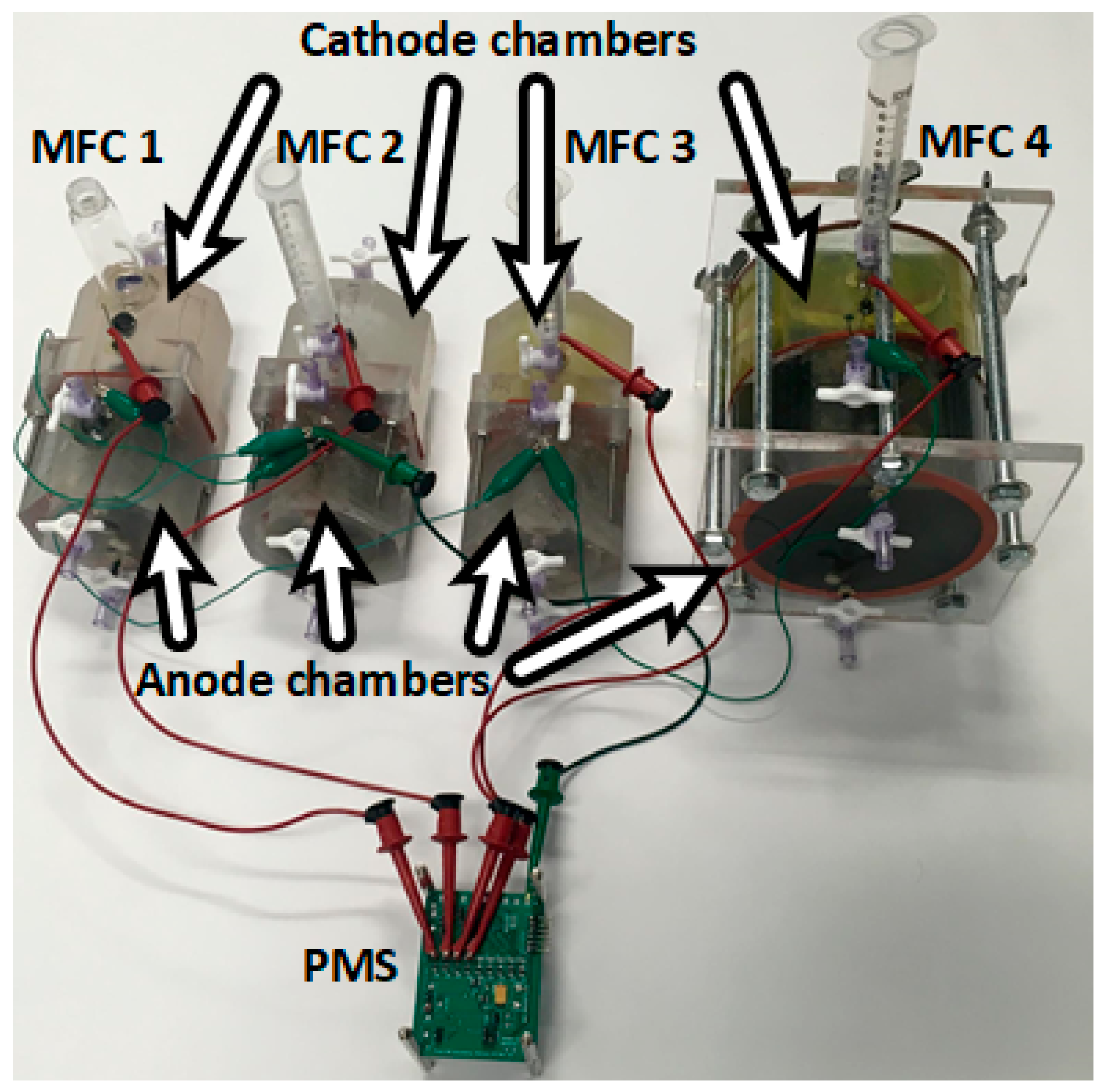

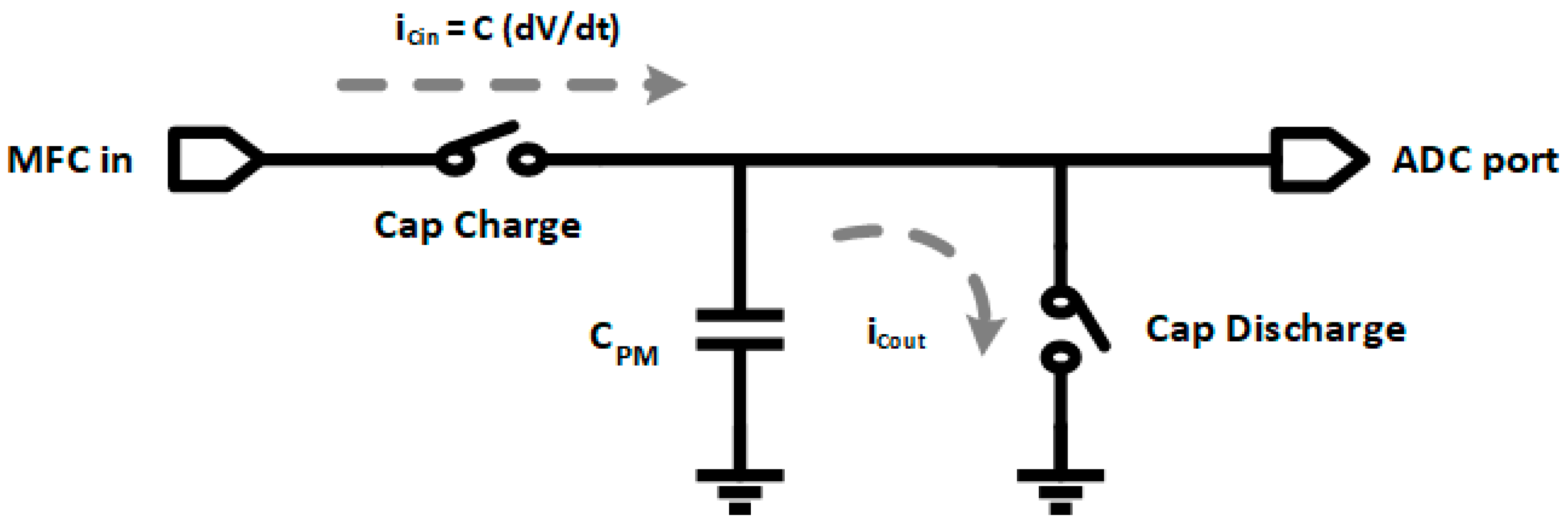
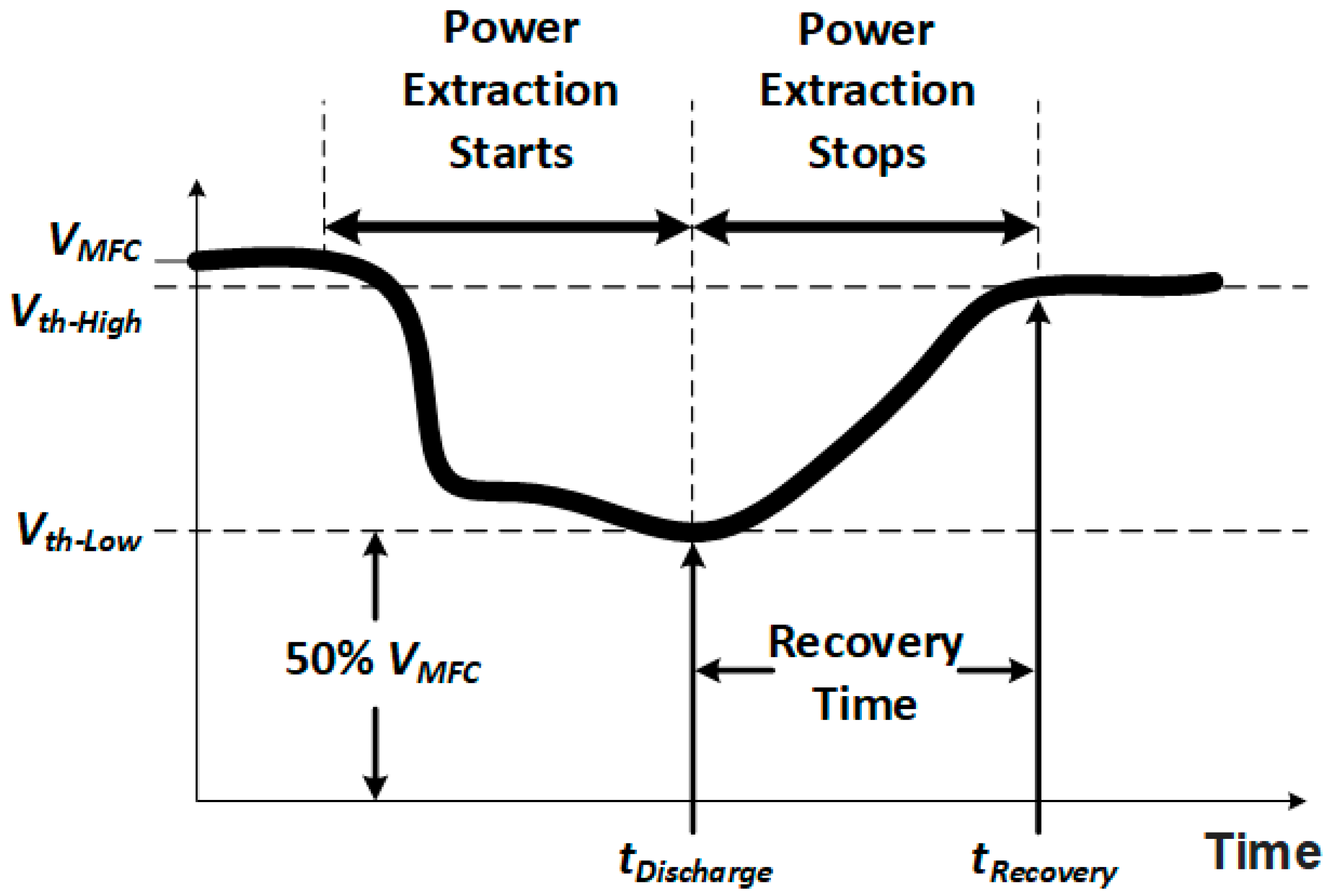
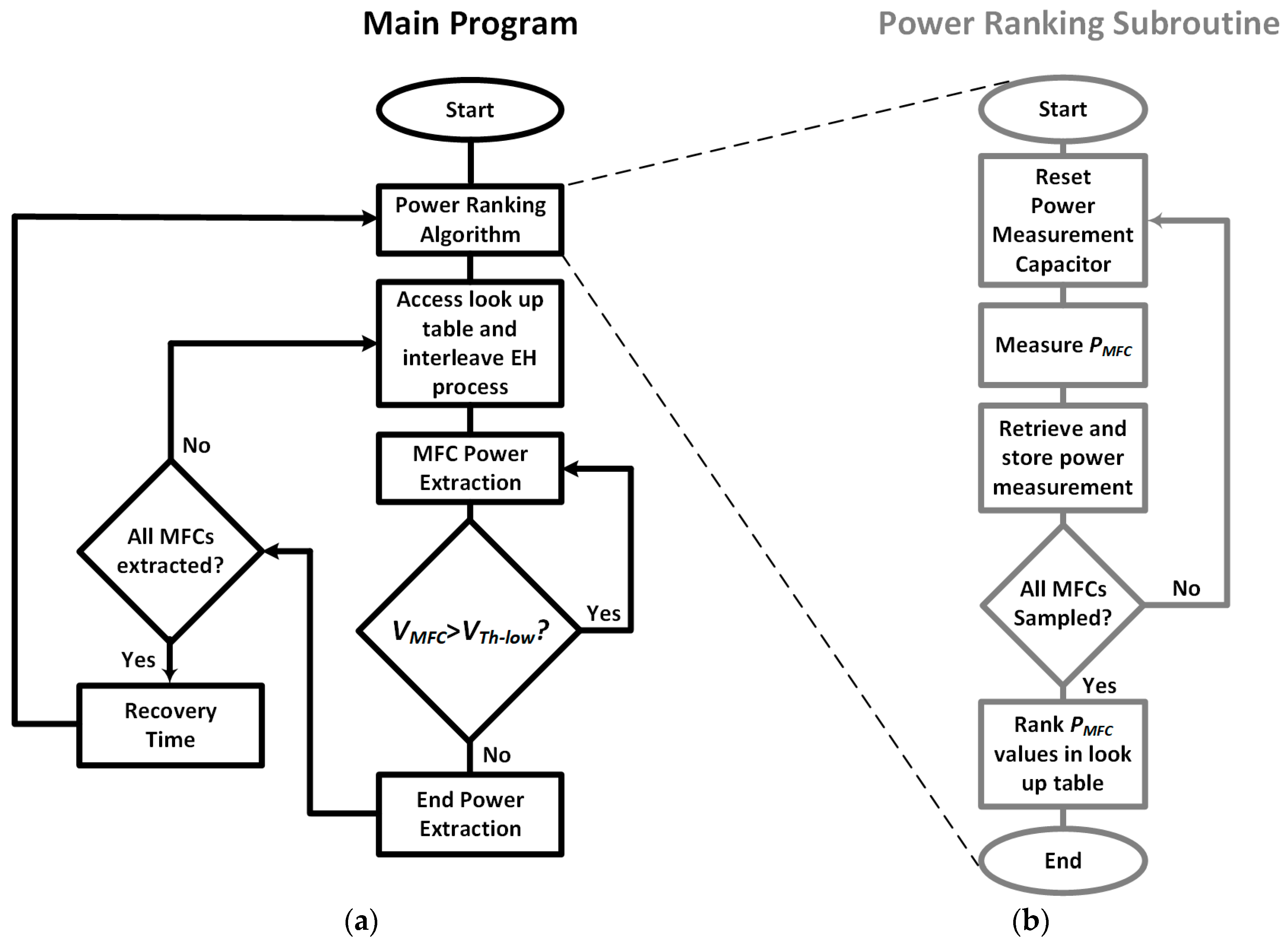
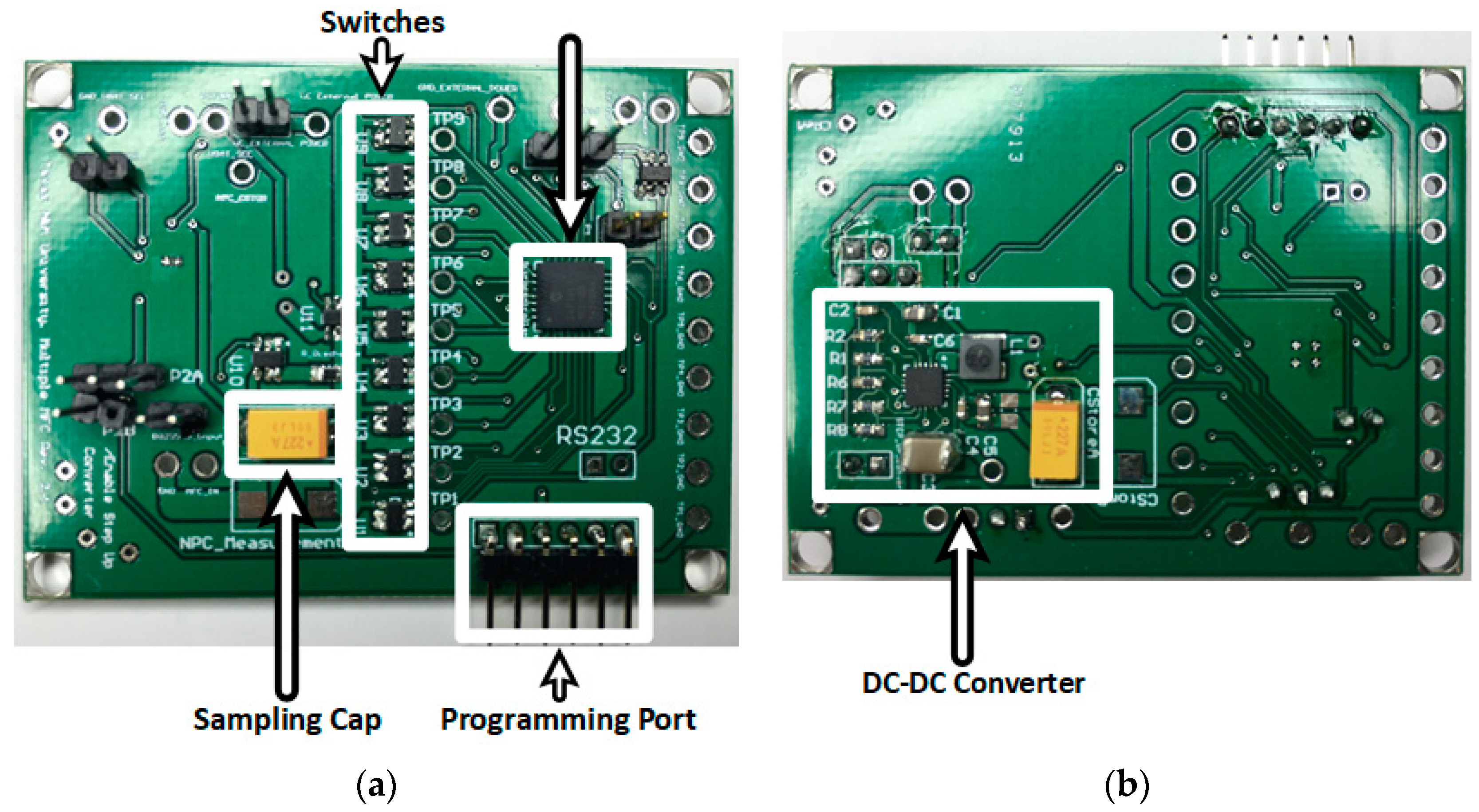
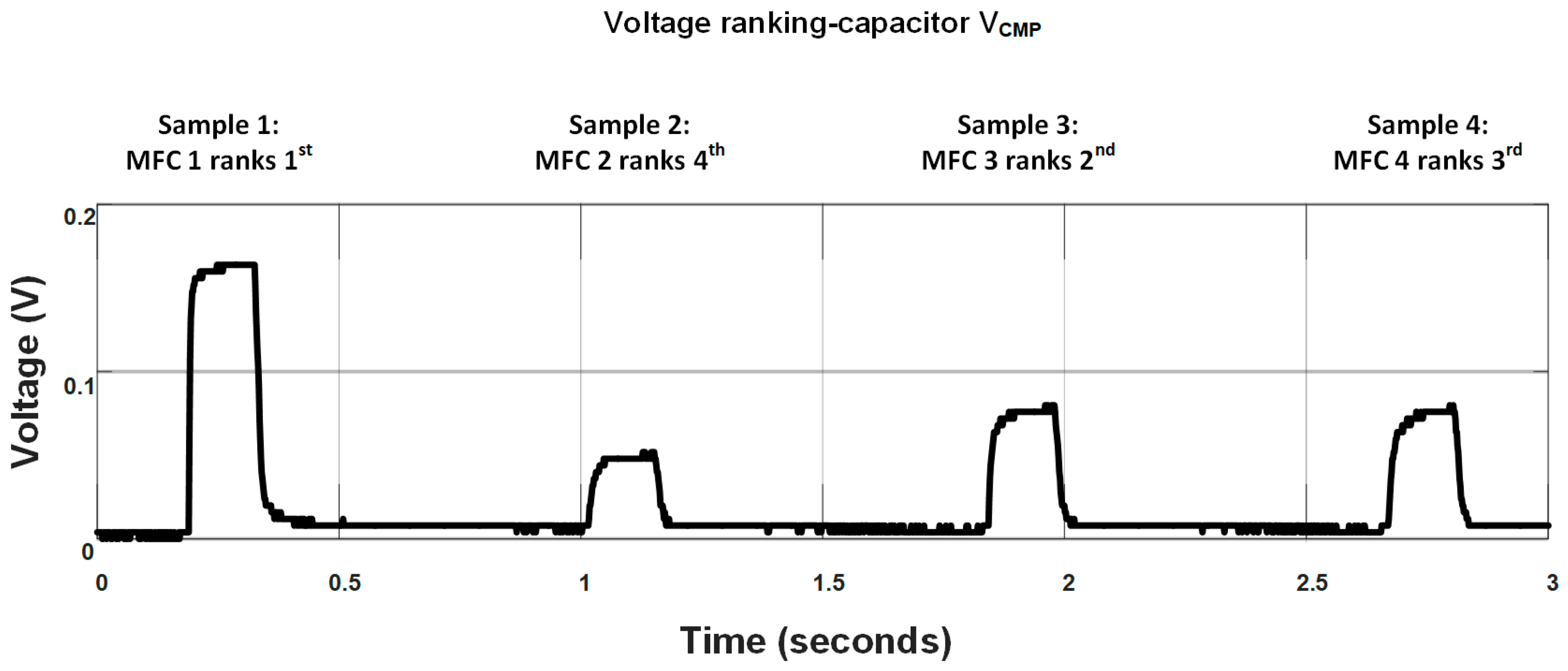
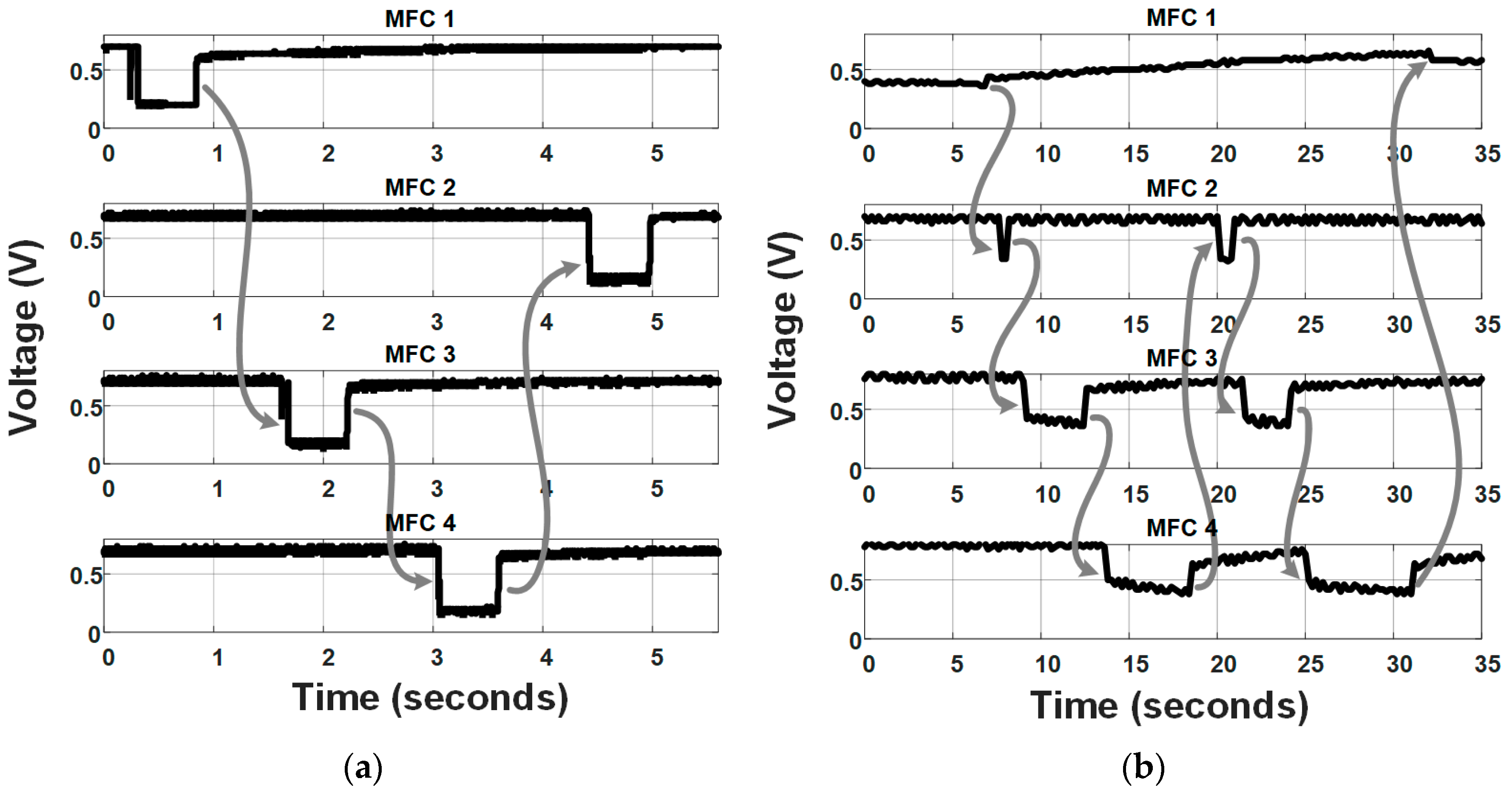
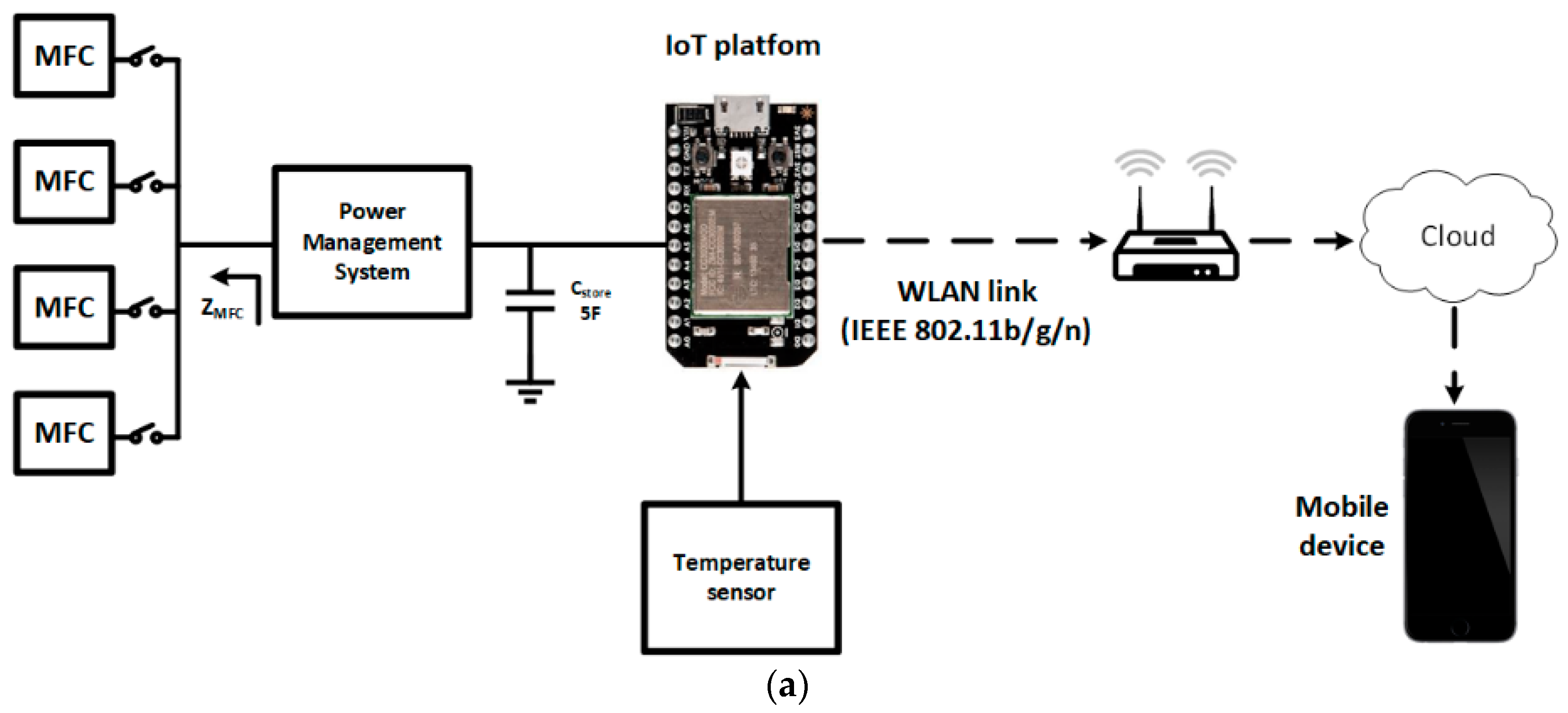
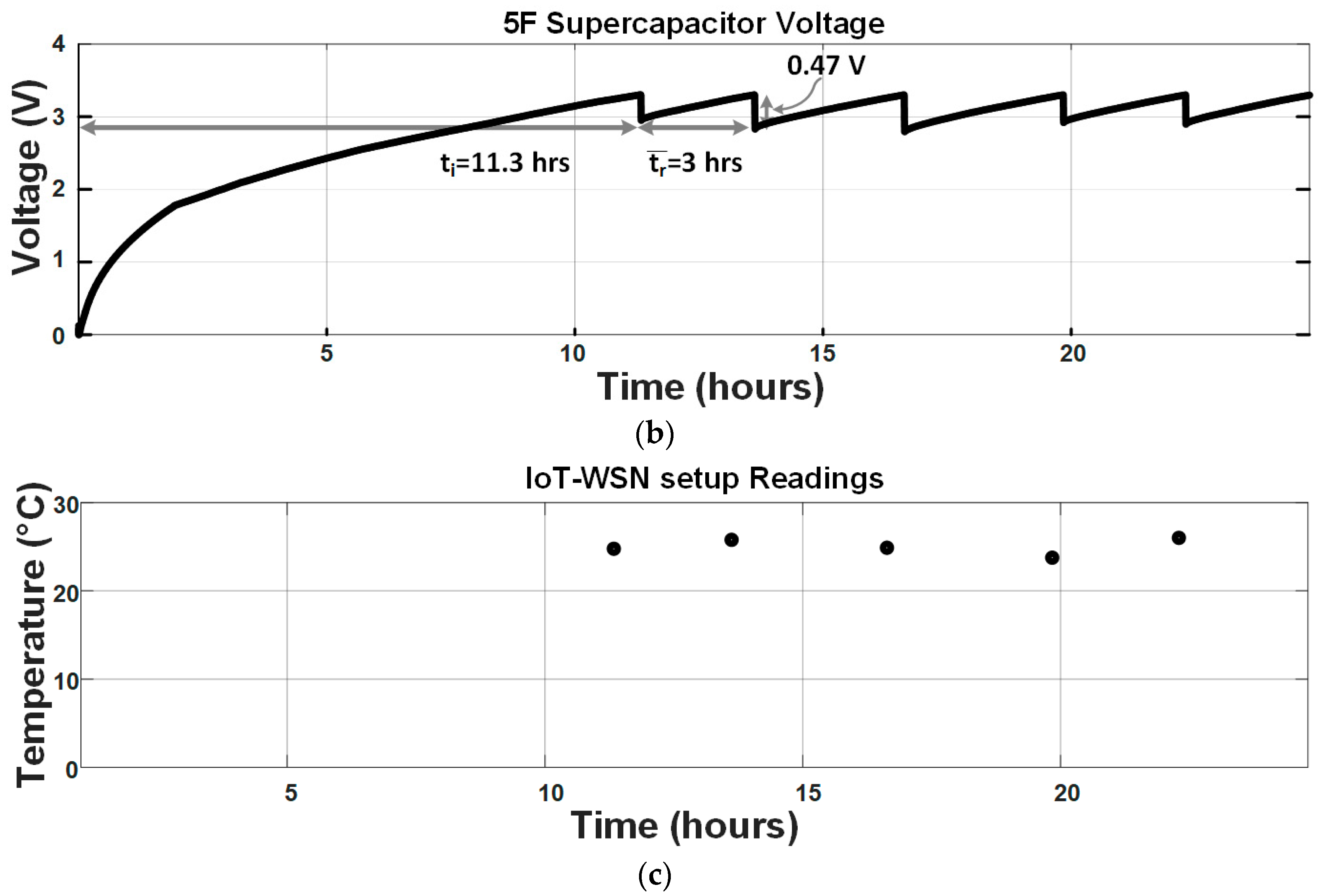
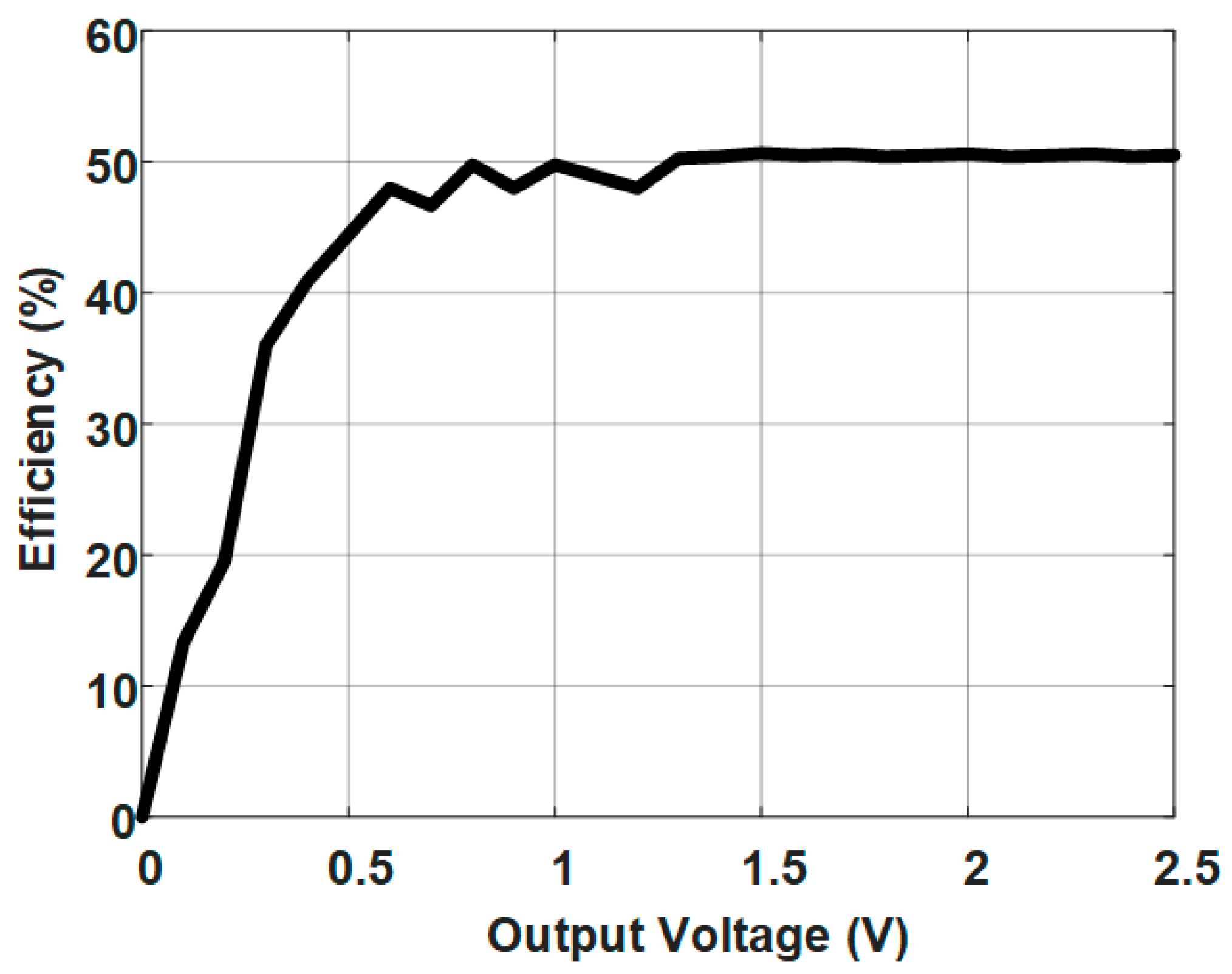
| MFC 1 | MFC 2 | MFC 3 | MFC 4 | |
|---|---|---|---|---|
| Total volume (mL) | 240 | 240 | 240 | 1000 |
| Catholyte | Air | Air | Ferricyanide | Ferricyanide |
| Anode area (cm2) | 12 | 12 | 12 | 50 |
| Cathode area (cm2) | 12 | 12 | 12 | 50 |
| Power @ maximum power point (MPP) (μW) | 595 | 484 | 435 | 6400 |
| Specification | Value |
|---|---|
| Number of MFCs | 4 |
| Average Vin | 350 mV |
| Vout | 3.3 V |
| Output supercapacitor | 5 F |
| Device | Ranking (Phase One) | Ranking (Phase Two) |
|---|---|---|
| MFC 1 | 1st | 1st |
| MFC 2 | 4th | 2nd |
| MFC 3 | 2nd | 3rd |
| MFC 4 | 3rd | 4th |
| Specification | [51] | [27] | [29] | [28] | [33] | [52] | This Work |
|---|---|---|---|---|---|---|---|
| Input voltage | 300 mV | 300 mV | 300–720 mV | 300–600 mV | 1.4 V (DC-DC converter input) | 300 mV | 330 mV |
| Output voltage | 1 V | 1.8 V | 2.5 V | 2.5 V | 4.25 V | 3.3 V | 3.3 V |
| Inductor | 1.5 mH | 1.5 mH | Transformer 31.8 mH (primary winding) | - | |||
| Output capacitor | 0.1 F (supercapacitor) | 0.1 F | 68 mF | Multiple | 5 F | ||
| Maximum power extraction | - | - | Adaptable Maximum Power Extraction | Yes | MPPT | - | MPPT |
| Efficiency | 73% | - | 58% | 30% | - | 35.02% | 50.7% |
| Implementation approach | Discrete Components | Discrete Components | Custom integrated circuit | Custom integrated circuit | Discrete Components | Discrete Components | Discrete Components |
| Multiple MFC power extraction | No | No | No | No | Yes | Multi anode | Yes (default support for 9 MFCs) |
| MFC health protection | - | - | - | - | No | No | Yes |
© 2018 by the authors. Licensee MDPI, Basel, Switzerland. This article is an open access article distributed under the terms and conditions of the Creative Commons Attribution (CC BY) license (http://creativecommons.org/licenses/by/4.0/).
Share and Cite
Costilla Reyes, A.; Erbay, C.; Carreon-Bautista, S.; Han, A.; Sánchez-Sinencio, E. A Time-Interleave-Based Power Management System with Maximum Power Extraction and Health Protection Algorithm for Multiple Microbial Fuel Cells for Internet of Things Smart Nodes. Appl. Sci. 2018, 8, 2404. https://doi.org/10.3390/app8122404
Costilla Reyes A, Erbay C, Carreon-Bautista S, Han A, Sánchez-Sinencio E. A Time-Interleave-Based Power Management System with Maximum Power Extraction and Health Protection Algorithm for Multiple Microbial Fuel Cells for Internet of Things Smart Nodes. Applied Sciences. 2018; 8(12):2404. https://doi.org/10.3390/app8122404
Chicago/Turabian StyleCostilla Reyes, Alfredo, Celal Erbay, Salvador Carreon-Bautista, Arum Han, and Edgar Sánchez-Sinencio. 2018. "A Time-Interleave-Based Power Management System with Maximum Power Extraction and Health Protection Algorithm for Multiple Microbial Fuel Cells for Internet of Things Smart Nodes" Applied Sciences 8, no. 12: 2404. https://doi.org/10.3390/app8122404
APA StyleCostilla Reyes, A., Erbay, C., Carreon-Bautista, S., Han, A., & Sánchez-Sinencio, E. (2018). A Time-Interleave-Based Power Management System with Maximum Power Extraction and Health Protection Algorithm for Multiple Microbial Fuel Cells for Internet of Things Smart Nodes. Applied Sciences, 8(12), 2404. https://doi.org/10.3390/app8122404






